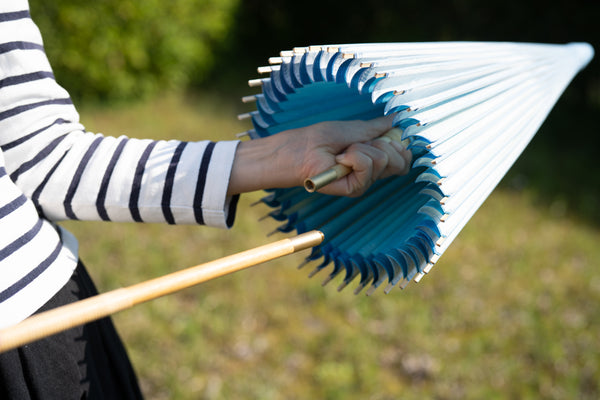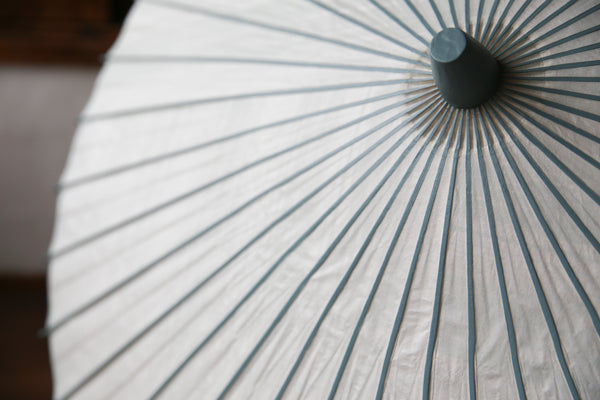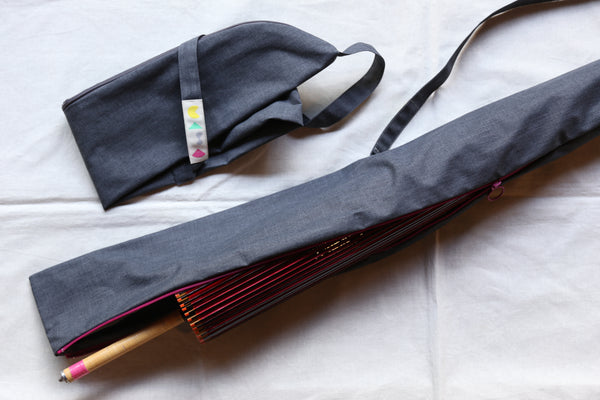Enjoy summer in style! The appeal of Japanese parasols

Recommendations for using Japanese umbrellas as parasols
Use a Japanese umbrella as a parasol on hot summer days to stay cool and comfortable! Japanese umbrella parasols protect you from the sun and glare, and also serve as a fashion accent. They are light, so they are recommended for beginners. We will answer questions about parasols, such as "Can a Japanese umbrella for rain be used as a parasol?" and "What is the difference between a Japanese umbrella for parasols?", as well as how to use them, their appeal, and points to note.

1. The benefits of using a parasol
Recently, more and more people are using parasols to protect themselves from the heat and sunburn. According to a survey by Weathernews, the national average of people who own a parasol is 33%, with nearly 80% of women and 10% of men owning one.
Regardless of whether it is a Japanese or Western-style umbrella, using a parasol has the following benefits:
- Protects skin from sunburn
- Protect your eyes from glare
- Protect yourself from the heat
In recent years, there are many stylish parasols, both Japanese and Western, that can be enjoyed as part of fashion.
The history of umbrellas actually began with parasols.
It is very convenient to have a Japanese umbrella parasol when going out in the summer, especially when wearing a kimono.

2. Features of Japanese umbrellas that can be used as "parasols"
Japanese umbrellas cannot be used in both sunny and rainy weather, so they should be used according to the purpose.
● The difference between rain umbrellas and parasol-type Japanese umbrellas
Typical Japanese umbrellas are coated with oil to repel rain and have a translucent appearance.
While it is beautiful when viewed from the inside, like looking up at stained glass, it does allow light to pass through, so it is not very effective at blocking out light.
It makes a beautiful umbrella to use for model photography at weddings, Shichi-Go-San ceremonies, etc., but the color of the umbrella will be clearly reflected in your face, so you will need to use some ingenuity, such as tilting it diagonally backwards.
Also, prolonged exposure to direct sunlight will cause the oil applied to the product to deteriorate more quickly.

On the other hand, Japanese umbrellas used as parasols are not oiled. The washi paper repels sunlight and casts a shadow on the inside. Many parasols have two layers of paper on the inside and outside to block out the light.
In addition, Japanese umbrellas used as parasols are made lightweight and easy to carry (the ribs and handles are shorter and have fewer ribs than regular Japanese umbrellas, etc. This varies depending on the production area and craftsman).

Click here for more information on compactly stored "tsugi-gara" type Japanese parasols.

How to easily distinguish between an umbrella and a parasol
In the case of "Gifu Japanese Umbrellas" made in Gifu, you can tell whether or not it is a parasol by looking at the top of the umbrella.
- There is no waterproof covering for the Janome umbrella or bangasa.
- It has the characteristic shape of a triangular pyramid with a flat top.
↓ Parasol 
↓ Umbrella (snake eye umbrella) ![Snake-eye umbrella [Sukeroku, white x persimmon tannin]](https://wagasa.shop/cdn/shop/products/IMG_6299_600x600.jpg?v=1646458835)
3. Differences between Western-style parasols and Japanese-style parasols
The biggest difference between Western and Japanese umbrellas is their design. Japanese parasols have a straight silhouette. They give a sharp and stylish impression to the wearer's fashion.
Japanese parasols with long handles embody traditional wisdom, as they allow people to avoid having to raise their elbows so high that their kimono sleeves get rolled up.

With nearly 40 ribs, you can enjoy the delicate beauty of these umbrellas. Also, Japanese umbrellas are made from natural materials and are pleasant to the touch.
If you choose a parasol in a dark color close to black, it will block the sun more effectively, making the temperature feel cooler.
4. Three profound charms of Japanese parasol-type umbrellas
Beautiful from inside and out
Many Japanese parasol-type umbrellas are made with a "double layer" (furoshiki) method, in which paper is pasted on both the outside and inside of the umbrella.
Different washi paper is often used on the outside and inside of the umbrella, which creates three different impressions: the difference in impression between the inside and outside, and the shadows cast by the sun shining through it.
![Parasol [double layered navy blue x Maru lace]](https://cdn.shopify.com/s/files/1/0384/6232/4869/products/IMG_9987_600x600.jpg?v=1671266253)
Combined with the geometric thread stitching, it adds a touch of glamour around the face, making it look brighter and more attractive.
As you walk under the roadside trees, the sunlight filtering through the washi paper changes color, creating a very picturesque atmosphere.
It looks like going out will be even more fun.
Video of sunlight filtering through the trees ↓
● A craft feel that will captivate stationery girls and craft-loving boys
Unlike rain umbrellas, Japanese umbrellas do not get wet in the rain, so they are made using intricately patterned or colorfully dyed washi paper and come in a wide variety of designs.
This is a must-see for paper lovers, as you can enjoy the beauty of washi paper to your heart's content.
![Parasol [Tsukiyakko Pink x Hydrangea]](https://wagasa.shop/cdn/shop/products/DSC_0182_600x600.jpg?v=1632940021)
![Parasol [Eaves Blur Pink Turquoise]](https://wagasa.shop/cdn/shop/products/DSC_3926_600x600.jpg?v=1614191209)
● It lasts a long time because it doesn't get wet! A cost-effective Japanese parasol
Japanese umbrella parasols do not require any special care, and if you handle them with a little care, they will last long enough to justify their price.
Regular Japanese umbrellas are coated with oil to make them water repellent. Over the years of use, the oil on the surface oxidizes and the washi paper can turn yellow, crack, or stick together.
Parasols, on the other hand, are not oiled, so unless the ribs are damaged, the lifespan of the umbrella is the same as the lifespan of the washi paper. The durability of washi paper is remarkable, as washi paper dating back 1,500 years has been found in the Shosoin Repository.
It's nice to be able to use your favorite item for a long time.
![Ajiro Parasol [Ishitoshiro Indigo Dye 2021 Layer]](https://cdn.shopify.com/s/files/1/0384/6232/4869/products/IMG_6871_600x600.jpg?v=1651401996)
5. Things to be aware of when using a Japanese umbrella
When using a Japanese umbrella as a parasol, please pay attention to the following points.
Do not get wet with rainwater
If it does get wet in the rain, open it carefully so the washi paper doesn't stick together or peel off, and let it dry completely before storing it away.
Do not get caught on tree branches, etc.
Especially when you go out in a kimono, there are so many things to be careful about that you tend to forget about your umbrella. Be careful not to let your umbrella hang down under the eaves, go into the shade of a tree, or get too close to the umbrella of someone else... Be careful not to hit it with sharp objects.
If a hole does appear, if it is a small hole, you can cover it yourself with washi masking tape.
● Protects the top of the Japanese umbrella from impacts.
A general rule of caution for Japanese umbrellas is to protect the head part (the wheel) that holds the frames together from strong impacts so that it doesn't break.
The part that touches the floor when closed is the handle side, opposite to Western umbrellas. When carrying it, hold it upside down so that it doesn't open. We recommend using a bag for Japanese umbrellas. You can carry it with both hands free for peace of mind. You can hang it up when storing it, and if you want to put it aside for a while, a cover will prevent it from getting dirty.
![Parasol [double layered openwork pattern "hemp leaf" x persimmon tannin]](https://cdn.shopify.com/s/files/1/0384/6232/4869/files/DSC_0146_e2a9ebee-acc6-42a4-95f1-aa3e14a9b152_600x600.jpg?v=1694673720)

![CASA original parasol carrier bag [Iteshiro Clothing Store] - Japanese umbrella CASA](https://cdn.shopify.com/s/files/1/0384/6232/4869/products/IMG_1405_600x600.jpg?v=1600936895)
![CASA original parasol carrier bag [indigo dye & persimmon tannin dye/Mino handmade washi paper]](https://cdn.shopify.com/s/files/1/0384/6232/4869/files/CASA_600x600.jpg?v=1715349248)
Click here for details on Japanese umbrella bags
6. How to care for the product after use
No special care is required after normal use.
It is best to place it upright with its head facing up in a well-ventilated, shady spot.
If you open it once a week and use it moderately, you will be able to notice the changes more easily and it will last longer.
Enjoy a stylish summer with a cool looking Japanese umbrella!
Japanese umbrella parasols are a cool and elegant way to enjoy the summer. Experience the traditional beauty of Japan and spend your summer in style!
Click here for a list of Japanese umbrellas


![CASA Original Parasol Carrying Bag [Persimmon Juice] - Japanese Umbrella CASA](https://cdn.shopify.com/s/files/1/0384/6232/4869/products/IMG_1931_600x600.jpg?v=1602700378)
